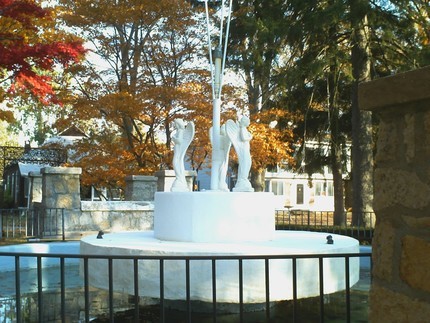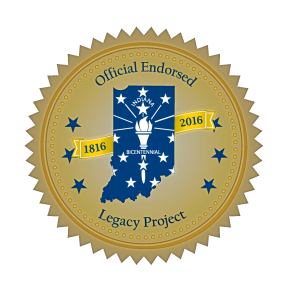IF THE RIVER COULD TALK
SPIRITUALISTS GATHER AT THE RIVER
Sunflower Hotel Expanded While the Waterworks Rebuilt

If the River could talk, it would tell of a place on its left bank a mile west of where the river enters Madison County immediately north of the town of Chesterfield. It is a place of great beauty where the land, which is abundantly adorned with large trees that shade eye-appealing green lawns, falls gently to the river's edge. And, if the wind is just right, cooling bre33zes from the river seep through the shade of the high, old trees to refresh the grounds at their highest point. That area today, known as Camp Chesterfield, is where the cottages and other buildings, 65 in all, now stand.
It was this same delightful place that a group of local people known as Spiritualists and members of the recently formed Indiana Association of Spiritualist chose to hold a camp meeting in 1891. That decision was made a year earlier during a church picnic held on the riverside property of Carroll and Emily Bronnenberg. The Bronnenbergs made the new campsite possible by selling 34 acres of their property to the association on August 12, 1892, for the sum of $3,225.
Three local couples, the Bronnenbergs, Dr. George and Caroline Hilligoss and Dr. John and Mary Westerfield were instrumental in the initial formation and leadership of the Spiritualist movement that resulted in the establishment of Camp Chesterfield.
Two of the principal beliefs of the Spiritualists are that the existence and personal identity of the individual continues after death, and that communication with the so-called dead is a fact, scientifically proven by the phenomena of Spiritualism. It's that belief that most likely explains the strong involvement of the Westerfield and the Hilligoss families.
The Westerfields experienced the death of their only child, John Jr., at the age of 13 on July 23, 1856. He is buried in West Maplewood Cemetery. It is in that same cemetery that both of the Hilligoss' children are buried: Gertrude Pauline in 1881 and Charles Ingersoll in 1887. For many years Dr. and Mrs. Hilligoss would drive their horse and buggy to the cemetery and park along Grand Avenue to spend a quiet Sunday afternoon at the graveside of their children.
In the beginning, the first places of dwelling were tents that surrounded the first Auditorium, which was erected in 1891. It was nothing more than a large tent with wooden appointments. The initial Auditorium was replaced in 1903 by a wooden frame Auditorium. Three years earlier, in 1900, the campground had seen many improvements, including fences, wells, natural gas lines, more cottages, two Seance Rooms, a dining hall, a bazaar and store and a lodging house that accommodated 25 people.
Early on, the mediums were there from the middle of July to Labor Day. They held seances in the Auditorium or Seance Rooms. People attending were expected to pitch a tent, cook their own meals and make use of the convenient woods for whatever else was necessary. This worked for a while until the idea caught on the the numbers of visitors and workers grew. Between 1910 and 1920, more facilities appeared to accommodate the increasing popularity and corresponding attendance.
In 1914, the Sunflower Hotel containing 70 rooms was built to keep pace with the increasing demand for lodging. From 1922 to 1924, the Sunflower Hotel was expanded with the addition of more rooms. The waterworks was rebuilt and larger pipes installed to keep up with the camp's expansion. A 35-foot diameter cistern was installed behind the old wooden dining hall, which was built in 1918. Today, Maxon Cafeteria which was constructed in the mid-1950s, is a full-service dining facility that hosts social events, receptions, and large meetings. Also, during this time, a sewer system was installed, public restrooms built, and indoor toilets were added to the hotels.
The grounds contain certain significant landmarks. In 1936, Founders Rock was moved from the White River and placed in front of the current Administration Building. In 1940-41, the Shrine dedicated to the American Indian, located on Inspiration Hill, and the Sentinel Angel, standing at the entrance to the Garden of Prayer, were erected and dedicated. In 1945, construction of the Western Hotel was authorized. In 1954, the wooden Auditorium built in 1903 was removed and replaced. And on June 16, 1954, the Cathedral of the Woods was dedicated.
If the river could talk, it would tell of the Dr. J. E. Hett Art Gallery and Museum dedicated in 1955. Here is housed a unique collection of Spiritualist-related historical objects and artwork. It would also tell of a simple frame church called The Chapel in the Woods, which is the heart of Camp Chesterfield and has served the camp's religious and social life for generations.
Yes, the river would have much to say about those who have gathered on its banks to worship and practice their religious beliefs. And the untold numbers who have embraced the teachings of the Moravians and Spiritualists would perhaps have much to say about the river.
Stephen T. Jackson, Madison County Historian

Throughout Indiana's Bicentennial year of 2016, Steve Jackson, Madison County Historian, will be authoring "If The River Could Talk." This series will feature people, places, and events that takes place in and around White River.
The series is an officially endorsed legacy project of the Indiana Bicentennial Commission.
Madison County Historical Society|15 West 11th Street, P. O. Box 696, Anderson, Indiana 46015-0696|(765)683-0052|madisonchs10@gmail.com